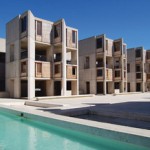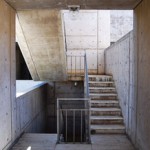Undoubtedly, there are three basic reasons why the Salk Laboratories are worth travelling 11,000 km, to the “end” of the western world, in La Jolla. The first one concerns the professional need of direct experience of an architectural masterpiece designed by Louis Khan in 1959-1965; it has indeed a deep spiritual meaning that cannot be captured from pictures or narratives and what is more, the prevailing geological and geographical landscape seems to make it a prisoner of trans-historic or cosmic eternity being thus unreachable by social and cultural changes.
The second reason emerges from the institution’s real life and its challenging inescapable problems of the adjustment of a trans-historic object to various uses generated by the ever-changing social needs; thus, one cannot overlook the ethical controversy around the recent extension of the labs – the eastern wing designed by the Anshen + Allen Office. Finally, the third reason is related to the “aura” of the architectural monument, which inevitably results from mechanisms of professional and cultural deterritorialization; the object-as-example is interpreted and uprooted from its specific context and thus it inspires the work of other architects or architectural schools. Having said that, one should consider the Salk laboratories beyond their historiographic canonic image, as a body of professional principles that withstood the test of time and could still help prospective thinking.
The institute stands on the eastern side of a flat ground, quite close to the seashore, being 60 m higher than the narrow strip of beach. There is a deep ravine piercing two thirds of the middle line of the terrain, thus breaking the waterfront and emphasizing the nature of the place; this particular factor is an inspiration for the architectural “splitting” of the building volumetric shape and of the pile in general. Louis Kahn articulated three essential concepts: 1. Separation of the perimeter walls as to the major structure (which defines the prevailing area of the laboratories) with a view of exposing them to a more dramatic interplay between light and shadow thus making them look like some “enveloping ruins”; 2. Sever, serial, and hierarchical articulation of the volumetric shapes identified in their own geometry and structure according to the metaphor of “society’s spaces”; 3. Clear-cut functional distinction between “serving” and “served” spaces, displaying in horizontal and vertical section simultaneously1. By totally coming to terms with the initiator of the project, the biologist Jonas Salk’s thought and work, the American architect believed that the intervention, apart from the nature of the place and the meeting of the researchers’ needs, as a memorable construction that “Picasso could visit” 2, meant for meetings and dialogues between science, art, humanities, and architecture.
Kahn’s deep experience in Italy, Greece, and Egypt among ancient ruins left an indelible mark on his project for the Salk Institute; thus, various historic typologies melted into the project from its early stages: the Roman villa, the medieval castle, the cruciform church and the abbey3. The inner court, opening onto east-west to the ocean and continent emphasizes the monastic nature of this place dedicated to science, becoming, as Luis Barragán put it (when invited on the site for an informal though legendary meeting with Jonas Salk and Louis Kahn in 1965), a “façade opened to heaven”4. Originally, Kahn designed the courtyard as a place sunken in vegetation, yet it kept its mineral aspect discretely animated by the creek flowing from the eastern fountain and leaking through the gutter embedded in the travertine floor to the western ponds. Thus, it results in a cosmic garden dedicated rather to eternity than to a mere socializing place for scientists. The general significance of this project seems to be related to an essential philosophical and cultural aspect that Robert Venturi strongly emphasized when he protested against the extension commissioned to the Anschen+ Allen Office in 1994. Then, he explained that any addition to the access area shakes the philosophical grounds of Kahn’s project, the basis on which it revealed itself in the natural and urban context, a fact that goes hand in hand with an American way of thinking geography and society in constant expansion5.
The historic and functional positions upheld by the author and speculatively traced in Kahn’s texts and drafts were motivated by a need to adjust the institute to new public demands, and doubled by his respectful attitude to the master’s architectural vocabulary6.
However, he pushed his respect too far and so, the mimetic language puzzle even professionals. Thus, shadowed by the ethic debate around an absolutely necessary extension (along with some further additional spaces for which they have been waiting for the green light), Kahn’s work defies time and irreversible changes. The universality of language, the elementariness of forms, the poetics of manipulating light and a subtle interpretation of archetypes and classical typologies filtered through contemporary constructive practice render the La Jolla architectural masterpiece a relevant example for current practice. The variety of today’s borrowings shows a structural divergence as to the post 1960 architectural aesthetic theory. The postmodernist reception of Kahn’s work as Robert Venturi and David Scott Brown defend it as a “in-disciplined” and challenging manner promote iconography, representativeness, contradiction and complexity; in fact, both of them see Kahn in the context of his time as a mentor and guide that could be “defeated” as much as the modernist paradigm could be “abandoned” for a better, more adjusted one to new social challenges. The late-modernist trend, which hates paradigm “breaks”, tries to put back on track the aesthetic continuity by retrieving modernity critically by creating an ethical basis concerning essential typological (formal rigor), topological (adjustment to context), and tectonic principles (structural poetics and the presence of all senses in the perception of any architectural work). From this integrating vision, a long list of contemporary architects, either Japanese, Spanish or Swiss (Tadao Ando, Rafael Moneo, Alberto Campo Baeza, Juan Navarro Baldeweg, Luigi Snozzi, Peter Zumthor, Valerio Olgiatti, Livio Vacchini, Andrea Deplazes, etc.) answered this critical challenge and gave relevant answers that celebrate the reinventing of architectural details and a multi-sensorial approach of materials. Thus, Kahn’s work is one of the most fertile grounds of architectural inspiration, beyond the formal model; it stands for a coherent body of theoretical principles from which interpretation could benefit for the formation of new aesthetic trends.
Postmodernism and late modernism share, despite their aesthetic disagreement, the same interest for Kahn’s deep critical approach of modernist architecture, that is, the idea of a hierarchy of space able to go beyond the naïve expression of pure technology, the concept of rooms defined by closure or structure, the principle of firm foundation for walls, the new enquiry into the expressiveness of limited openings within walls, “layered envelops” to created intermediary spaces or interstices, and last but not least, his high regard for the natural or built environment. Beyond various historiographic interpretations, Kahn stays as a deep spiritual, extremely rigorous architect and, paradoxically, as one who met the challenges of his own time and society by refining a set of timeless principles working beyond the confines of his profession.
- Robert McCarter, Louis I. Kahn, Phaidon Press, Paris, 2007, p. 38.
- Louis Kahn, „Talk with Students”, 1964 in Alessandra Latour, ed., Louis I. Kahn: Writings, Lectures, Interviews, New York, Rizzoli, 1991, p. 163.
- McCarter, Op. cit, pp. 210-216.
- Louis Kahn, „Silence”, 1968, in Latour, Op. cit, pp. 232-233.
- Robert Venturi & Denise Scott Brown, „A Protest Concerning the Extention of the Salk Center”, in Robert Venturi, Iconography and Electronics Upon a Generic Architecture – a view from the drafting room, The MIT Press, Cambridge MA, 1998, pp. 81-83 (initially published as „Genius Betrayed” in Architecture, July 1993, p. 43).
- Tom Spector, The Ethical Architect, Princeton Architectural Press, 2001 , p. 168.




